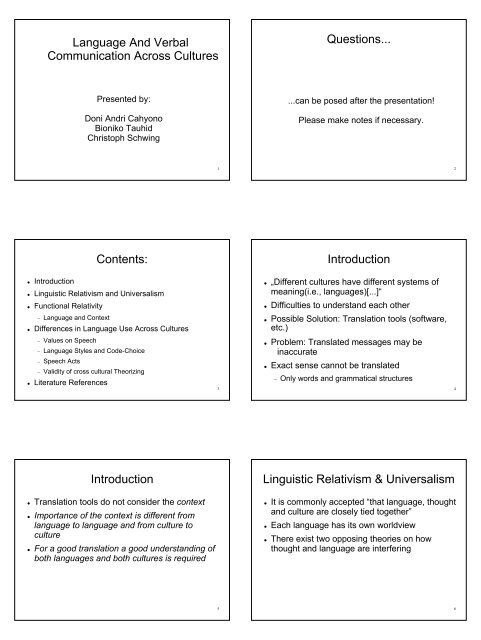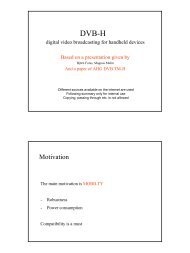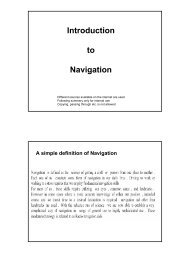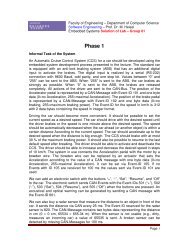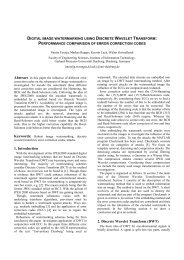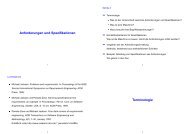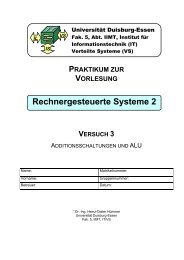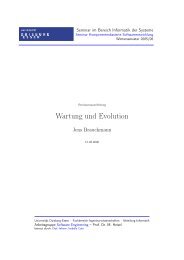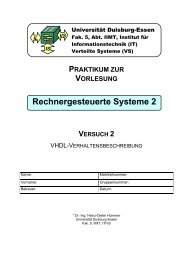Language And Verbal Communication Across Cultures Questions ...
Language And Verbal Communication Across Cultures Questions ...
Language And Verbal Communication Across Cultures Questions ...
Create successful ePaper yourself
Turn your PDF publications into a flip-book with our unique Google optimized e-Paper software.
<strong>Language</strong> <strong>And</strong> <strong>Verbal</strong><br />
<strong>Communication</strong> <strong>Across</strong> <strong>Cultures</strong><br />
Introduction<br />
Presented by:<br />
Doni <strong>And</strong>ri Cahyono<br />
Bioniko Tauhid<br />
Christoph Schwing<br />
Contents:<br />
Linguistic Relativism and Universalism<br />
Functional Relativity<br />
− <strong>Language</strong> and Context<br />
Differences in <strong>Language</strong> Use <strong>Across</strong> <strong>Cultures</strong><br />
− Values on Speech<br />
− <strong>Language</strong> Styles and Code-Choice<br />
− Speech Acts<br />
− Validity of cross cultural Theorizing<br />
Literature References<br />
Introduction<br />
Translation tools do not consider the context<br />
Importance of the context is different from<br />
language to language and from culture to<br />
culture<br />
For a good translation a good understanding of<br />
both languages and both cultures is required<br />
1<br />
3<br />
5<br />
<strong>Questions</strong>...<br />
...can be posed after the presentation!<br />
Please make notes if necessary.<br />
Introduction<br />
„Different cultures have different systems of<br />
meaning(i.e., languages)[...]“<br />
Difficulties to understand each other<br />
Possible Solution: Translation tools (software,<br />
etc.)<br />
Problem: Translated messages may be<br />
inaccurate<br />
Exact sense cannot be translated<br />
− Only words and grammatical structures<br />
Linguistic Relativism & Universalism<br />
It is commonly accepted “that language, thought<br />
and culture are closely tied together”<br />
Each language has its own worldview<br />
There exist two opposing theories on how<br />
thought and language are interfering<br />
2<br />
4<br />
6
Linguistic Relativism<br />
Linguistic relativity principle:<br />
„which means, in informal terms that users of<br />
markedly different grammars are pointed by their<br />
grammars toward different types of observations<br />
and different evaluations of externally similar<br />
acts of observation, and hence are not<br />
equivalent as observes but must arrive at<br />
somewhat different views of the world“<br />
(Whorf 1956)<br />
Linguistic Universalism<br />
Linguistic Universalism<br />
− Is an opposing theory to the 'Linguistic relativity<br />
principle'<br />
− It states that thinking is not dependent on the<br />
spoken language<br />
Cognitive sciences:<br />
− “mind is inbuilt capacities that have universal<br />
properties”<br />
− Our 'inner language' is universal<br />
Functional Relativism<br />
Now we will have a look at the functional aspects<br />
of Linguistic Relativism<br />
7<br />
9<br />
11<br />
Linguistic Relativism<br />
The linguistic relativity principle states:<br />
− <strong>Language</strong> influences the way of thinking<br />
As an example:<br />
− Comparison of English and Hopi-language<br />
− English:time treated as an object, countable<br />
− Hopi: time treated as a recurring event<br />
Linguistic Universalism<br />
Universal elements:<br />
− Basic terms as colours, etc. may be universal<br />
− Table is a table<br />
− Water is water<br />
Validity of Linguistic Universalism<br />
− Single lexical items<br />
− Connected items creating a grammar are no more<br />
universal<br />
<strong>Language</strong> and context<br />
8<br />
10<br />
12
<strong>Language</strong> and context<br />
Bernstein(1971) while examining children's<br />
language, learned that different classes within a<br />
single-language community use different type of<br />
language.<br />
Children from middle-class family used what<br />
called elaborated code.<br />
Children from lower working-class family used<br />
the restricted code.<br />
Restricted code<br />
<strong>Language</strong> and context<br />
employs short simple grammar and often incomplete<br />
sentences of poor syntactic structure.<br />
is rigid and limited in the use of adjectives and adverbs<br />
manifests small vocabulary and context-bound<br />
requires many shared experiences.<br />
The speaker's intention is implicit and unelaborated.<br />
Speech shows high dependency on extraverbal<br />
channel.<br />
<strong>Language</strong> and context<br />
Positional oriented family<br />
<strong>Communication</strong> system is closed, what one<br />
allow to say or not allow to say depend on the<br />
position in the family hierarchy<br />
Members are seen as of the occupant of the<br />
position in the family hierarchy<br />
Use imperatives mode of control, ask the<br />
children to pursue the obligation that the<br />
occupant of the position must fulfill.<br />
13<br />
15<br />
17<br />
Elaborated code<br />
<strong>Language</strong> and context<br />
makes use of accurate and sophisticated<br />
grammatical structures.<br />
uses wide range of adjectives and adverbs<br />
manifests a relatively large vocabulary.<br />
The speaker's intention, therefore is explicit and<br />
verbally elaborated.<br />
Speech depends little on extraverbal channels.<br />
<strong>Language</strong> and context<br />
Bernstein (1971,1972) relates code not only to<br />
classes but also to family types.<br />
Positional oriented family<br />
Person oriented family<br />
<strong>Language</strong> and context<br />
Positional oriented family<br />
Children neither experience enough elaborated<br />
messages nor realize the necessity to elaborate<br />
their meanings.<br />
These children therefore acquire restricted<br />
code.<br />
14<br />
16<br />
18
<strong>Language</strong> and context<br />
Person oriented family<br />
Members are seen as equal individuals and<br />
judge by their individual qualities<br />
<strong>Communication</strong> system is open, all family<br />
members are allowed to communicate freely.<br />
Use personal appeals that are rational and<br />
personalized and required sophisticated skill of<br />
persuasion.<br />
<strong>Language</strong> and context<br />
Restricted code is also known as high-context<br />
communication.<br />
Elaborated code is also know as low-context<br />
communication.<br />
Roughly speaking,<br />
Eastern societies manifest high-context culture<br />
and more positional<br />
Western societies manifest low-context culture<br />
and more personal<br />
Values on Speech<br />
Zen Buddhists refer language as people’s capability<br />
of thinking, limiting the imagination and imposing<br />
biases, and therefore, they try to meditate without<br />
language and communicate beyond language.<br />
19<br />
21<br />
23<br />
<strong>Language</strong> and context<br />
Person oriented family<br />
Children grow up hearing a variety of messages<br />
that are delivered in well-elaborated manners<br />
and realize that they also have to elaborate to<br />
get their meaning across<br />
These children therefore acquire elaborated<br />
code.<br />
Differences in <strong>Language</strong> Use<br />
<strong>Across</strong> <strong>Cultures</strong><br />
Values on Speech<br />
Yum, 1988 :<br />
The belief of oneness, or a perfect harmony,<br />
became a tenet for all major East Asian religions<br />
including Taoism, Buddhism, and Confucianism.<br />
This will reflect how little faith Eastern cultures place<br />
in words. On the contrary, the Western cultures<br />
have developed a rich tradition of speech,<br />
subscribing to the principle of the universality of<br />
meanings.<br />
20<br />
22<br />
24
Values on Speech<br />
The Western culture of words and the Eastern<br />
culture of harmony are well illustrated in their<br />
respective explanations of the creation of the<br />
universe.<br />
e.g :<br />
Lao-Tze taught to stay away from words, saying,<br />
“To become the way the Nature intended you to be,<br />
you should speak rarely”<br />
(Tao De Jing, 23).<br />
Values on Speech<br />
As a matter of fact, prudent speech is always<br />
encouraged: “if a gentleman is frivolous, he will<br />
lose the respect of his inferiors” (Waley, 1938,<br />
p.85) and these religious teachings are deeply<br />
rooted in the mind of Asians (Gudykunst & Kim,<br />
1984).<br />
According to Western standard, those things are<br />
considered as typical of very reticent behaviour<br />
of Asians (Kang & Pearce, 1983).<br />
Values on Speech<br />
In Asian cultures, rhetoric has been too important<br />
to be severed from its religio-philosophical<br />
context. (Oliver, 1971, p.11).<br />
The Asian attitude toward speech and rhetoric is<br />
characteristically a holistic one; that is, the words<br />
are only part of, and are inseparable from, the<br />
total communication context, which includes the<br />
personal characters of the parties involved and<br />
the nature of the interpersonal relationship<br />
between them (Gudykunst & Kim, 1984).<br />
25<br />
27<br />
29<br />
Values on Speech<br />
Confusius demystifies Lao-Tze’s teachings and<br />
applies them to real-life communication. His<br />
teachings on verbal communication are no more<br />
liberal than those of Lao-Tze.<br />
He taught that “fancy words and embellished<br />
styles do not bear virtues and words more often<br />
than not cause troubles”<br />
Values on Speech<br />
Socrates, Plato, and Aristotle taught the importance<br />
of reasoning and logical persuasion on the other side<br />
of the world :<br />
This rhetorical tradition reflects in a profound way<br />
the Western cultural pattern of logical, rational, and<br />
analytical thinking. A primary function of speech in<br />
this tradition is to express one’s ideas and thoughts<br />
as clearly, logically, and persuasively as possible, so<br />
the speaker can be fully recognized for his or her<br />
individuality in influencing others. (Gudykunst & Kim,<br />
1984, p.140)<br />
Values on Speech<br />
Westerner value silence as a pause, empty<br />
space, absence of sound, or blank in<br />
communication (Hasegawa & Gudykunst, 1998)<br />
and it will make conversationalists become<br />
uneasy.<br />
European culture places a great premium not<br />
only on knowing but also on saying what one<br />
knows (Wierzbicka, 1991).<br />
26<br />
28<br />
30
Values on Speech<br />
Silence is not always valued in Asia since it is<br />
preferred to verbalization only when the latter<br />
poses a threat to the face of self or the other<br />
such as in disagreement, challenge, talking back<br />
to superiors, interrupting the other’s speech,<br />
breaking peace by initiating a conversation, and<br />
speaking out one’s knowledge. Therefore, when<br />
a response or active participation is expected by<br />
the other person, keeping silent is rather<br />
considered impolite or uncooperative.<br />
<strong>Language</strong>s Styles and Code-Choice<br />
The cardinal devotion of the Asian mind to the<br />
related concepts of unity and harmony (Oliver,<br />
1971 p. 10) gave rise to two crucial linguistic<br />
characteristics:<br />
1. status-markedness<br />
2. group-orientedness.<br />
Goldstein and Tamura (1975), after a lengthy<br />
comparison between Japanese and American<br />
English, concluded that Japanese focuses much<br />
more sharply on two elements, status and group,<br />
than does American English.<br />
<strong>Language</strong>s Styles and Code-Choice<br />
In Asia, status difference overrules social<br />
distance. Whenever one speaks to a superior or<br />
an elder, one has to employ honorifics no matter<br />
how close they may be. The informal one-down<br />
style in the Korean language is especially used<br />
toward intimate superiors. The formal one-up<br />
style is used toward inferiors who have already<br />
established respectable degrees of status.<br />
31<br />
33<br />
35<br />
Values on Speech<br />
Japanese viewed silence very negative in some<br />
situations. Particularly when communicating with<br />
a stranger, silence is considered more negative<br />
(Hasegawa and Gudykunst, 1998).<br />
<strong>Language</strong>s Styles and Code-Choice<br />
Indo-European languages use some isolated<br />
linguistic devices, such as pronouns (Brown &<br />
Gilman, 1960), address terms (Ervin-Tripp, 1974)<br />
and more or less imposing speech acts (Brown<br />
and Levinson, 1987), to mark status differences.<br />
Korean and Japanese manifests the differences<br />
in the whole system of language. Koreans<br />
distinguish five different styles of language in<br />
terms of formality: formal one-down, informal<br />
one-down, one-across, formal one-up, and<br />
informal one-up, in order of the respect<br />
manifested.<br />
<strong>Language</strong>s Styles and Code-Choice<br />
Asians tend to distinguish between the private<br />
code, language used when no third parties are<br />
present and the public code, language used in<br />
presence of others.<br />
In Japan, the parents or grandparents, when<br />
speaking to one another in the presence of<br />
children, mostly use the same kinship terms used<br />
by the children to respect the other’s status.<br />
32<br />
34<br />
36
<strong>Language</strong>s Styles and Code-Choice<br />
Age is one of the most important elements of status.<br />
In Korea, a difference of even one or two years in<br />
age creates a difference in status. Within the sibling<br />
group, age differences are well respected in<br />
Japanese and Korean families.<br />
Older siblings call the younger by name, younger<br />
siblings call the older by kinship terms such as<br />
“older brother” or “older sister” (Goldstein & Tamura,<br />
1975).<br />
These age differences outside family, nevertheless,<br />
are also well respected.<br />
<strong>Language</strong>s Styles and Code-Choice<br />
In English, one cannot carry on a conversation<br />
without pronouns, and one feels uncomfortable<br />
speaking when the name of hearer has been<br />
forgotten (Goldstein & Tamura, 1975). English<br />
speakers need to confirm constantly the<br />
individual identity of the other person.<br />
Speech Acts<br />
Asians compared to Westerners are very low in<br />
self-assertiveness.<br />
Japanese is more regulated than white English,<br />
which, in turn, is more regulated than black<br />
English (Kochman, 1981). Particularly between<br />
ingroups, Asians tend to suppress confrontations<br />
or expression of negative verbal messages.<br />
Courtesy often takes precedence over<br />
truthfulness (Gudykunst & Kim, 1984, p. 142)<br />
which leads Asians to give an agreeable and<br />
pleasant answer to a question when a literal,<br />
factual answer might be unpleasant or<br />
embarrassing (Hall & Whyte, 1960).<br />
37<br />
39<br />
41<br />
<strong>Language</strong>s Styles and Code-Choice<br />
Group identity in Japanese and Korean goes<br />
beyond identifying with ingroup members. Their<br />
languages manifest careful considerations not to<br />
separate the other from self.<br />
In Japanese and Korean, the confirmation of<br />
individual identities is avoided throughout the<br />
conversation by minimizing the use of you, I, and<br />
each other’s name. They can speak perfectly well<br />
with minimal reliance on pronouns (when the<br />
subject of a sentence is a pronoun, it is usually<br />
omitted) and are quite comfortable even if they<br />
cannot remember the other’s name (Goldstein &<br />
Tamura, 1975).<br />
Speech Acts<br />
Asians tend to be concerned more with the<br />
overall emotional quality of the interaction than<br />
with the meaning of particular words or<br />
sentences (Gudykunst & Kim, 1984, p. 142).<br />
They believe that in the long term their<br />
relationship –not their words- will help<br />
accomplish their communication goals.<br />
Speech Acts<br />
Asians tend to suppress expression of their emotion.<br />
Being emotional in Asian culture is believed to reflect<br />
a lack of self-control, which is a sign of a frivolous<br />
nature. Asians will say good instead of fantastic and<br />
not very good instead of terrible.<br />
Even when expressing strong personal affection, a<br />
style of hesitancy and indirectness is commonly<br />
preferred. Asians can even be suspicious of the<br />
genuineness of direct verbal expressions of love and<br />
respect. Excessive verbal praise or compliments<br />
sometimes are received with feelings of<br />
embarrassment (Gudykunst & Kim, 1984, p.142)<br />
38<br />
40<br />
42
Speech Acts<br />
Italian culture, Slavic cultures, Jewish culture,<br />
and American black culture are also very<br />
expressive. These cultures value “uninhibited<br />
emotional expression” whether feelings are good<br />
or bad (Wierzbicka, 1991).<br />
Low assertiveness and expressiveness of Asians<br />
inevitably lead to high ambiguity of their<br />
messages.<br />
Speech Acts<br />
The ways in Asians generate implicatures fall<br />
outside the scope of Grice’s theory. As Yoshikawa<br />
(1978) observes, what is verbally expressed and<br />
what is actually intended are two different things.<br />
To understand the real intention, one should not<br />
know the knowledge of conversation and<br />
contextual information but pure intuition obtained<br />
through a lengthy history of contact with the<br />
speaker.<br />
Validity of Cross-Cultural<br />
Theorizing<br />
In 1994, Lim reported that the “wants” to be<br />
autonomous, respected, competent, and<br />
accepted which correspond to Brown and<br />
Levinson claimed, in 1987, that universal theory<br />
of politeness was based on a dozen languages<br />
from all quarters of the world.<br />
43<br />
45<br />
47<br />
Speech Acts<br />
Ambiguity of messages prompted cultures<br />
emphasizing high-context communication to<br />
develop strategies to decode the message<br />
accurately. Even in Western societies where<br />
meanings are relatively well elaborated, more<br />
can be meant than what is actually said.<br />
Particularly when the speaker attempts to trigger<br />
not a “standard” but a “generated implicature” by<br />
“exploiting the maxims of conversation” (Grice,<br />
1975).<br />
Validity of Cross-Cultural<br />
Theorizing<br />
There are certain constant efforts have been<br />
made to identify universal features:<br />
1. Universal natural logic (Gordon & Lakoff,<br />
1975).<br />
2. Universal logic of conversation (Grice, 1975).<br />
3. Universal rules of indirectness (Searle, 1975)<br />
4. Universal logic of politeness strategy selection<br />
(Brown & Levinson, 1987)<br />
Validity of Cross-Cultural<br />
Theorizing<br />
Being reachable of a valid generalization on a<br />
particular pragmatic feature, one has to compare<br />
the whole system of the pragmatic feature of one<br />
language with those of other languages.<br />
This does not mean that there are no universals<br />
in language use. Comparative studies always<br />
yield certain similarities among cultures and<br />
seem to exist at atomic, semantic, or general<br />
levels, not at molecular, episodic, or specific<br />
levels (Gumperz and Levinson, 1996).<br />
44<br />
46<br />
48
Validity of Cross-Cultural<br />
Theorizing<br />
Universal of language use should be searched by<br />
focusing more on the basic semantic elements or<br />
semantic primitives, and the study on specific<br />
uses of language or pragmatics should be more<br />
sensitive to cultural diversity.<br />
49<br />
References<br />
Tae-Seop Lim, “<strong>Language</strong> and <strong>Verbal</strong><br />
<strong>Communication</strong> <strong>Across</strong> <strong>Cultures</strong>”, in Handbook<br />
of International and Intercultural<br />
<strong>Communication</strong>, W.B. Gudykunst and B.<br />
Moody, Eds. Thousand Oaks: Sage<br />
Publications, 2002, pp. 69-87<br />
50


